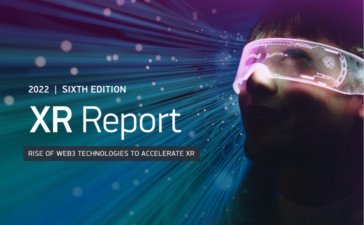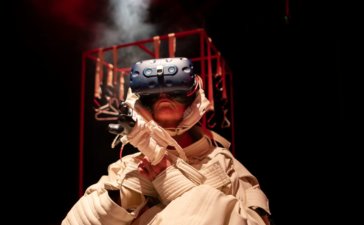Perkins Coie Releases 6th Annual Industry Report on Immersive Technology
The sixth annual Perkins Coie XR Report is out. The theme: “The Rise of Web3 Technologies to Accelerate XR.” While some people are skeptical of some of the goings-on in Web3, new ideas about connecting people are putting immersive technology into a context that highlights its value.
Is Web3 the Same as the Metaverse?
So far, ARPost has been largely silent on the idea of “Web3” because it brings in a lot of ideas that aren’t really central to immersive technology while not necessarily bringing in the immersive technology itself. For a quick and dirty shortcut, some people define the metaverse as “the next generation of the internet” and that’s exactly what Web3 means.
However, the metaverse movement is more focused on spatial computing while the Web3 movement is more focused on the mechanics of publication and ownership. So, the two aren’t necessarily mutually exclusive, but they are also not exactly the same thing. This issue was addressed in the report’s executive statement both as it benefits and potentially harms XR:
“Accelerated by . . . the emergence of NextGen technologies like Web3 and the metaverse, XR has hit the mainstream. Yet, new audiences, technologies, and products bring new challenges. When we add in the economic volatility that has at least temporarily affected many in the tech industry, the question becomes: What does the future have in store for XR?”
Overall, almost all of the respondents (significantly more than last year) expect to see growth in the immersive technology market, but the growth that they expect to see is more modest. Just under half of all respondents expect widespread adoption of the metaverse and Web3 in the next five years.
Insights on Investment
More people talking at a more reasonable volume was a trend in this year’s report. For example, 70% of respondents said that they would increase spending on XR for remote collaboration and training “to a moderate extent.” Last year, 51% said that they would increase this category of spending “to a large extent.”
Another 36% of respondents said that they expected the pace of investment to be “slightly higher” this year, while 32% percent expected that it would stay the same. This is significantly lower than the numbers for a similar question in last year’s survey.
Given otherwise growing positive sentiment, this might be less a reflection on immersive technology and more a reflection on the current state of the economy. Not only is the enterprise world increasingly returning to something like normal in terms of how internal communication happens, but rising costs in other sectors may lead to decreasing experimental budgets.
There are also remaining barriers to adoption of immersive technology.
Barriers to Adopting Immersive Technology
“Roughly half of respondents named user experience (e.g. bulky headwear and technical glitches) and content offering (e.g. lack of quality content) as barriers to mass adoption,” says the report. “Respondents expressed less concern on these fronts than they did in 2021, indicating that they perceive that the industry is making substantial progress.”
Respondents also said that improving data security, improving infrastructure, and improving affordability could all help to attract more consumers. Respondents also revisited one of the most interesting portions of last year’s report: the question of whether consumers or developers have a better understanding of compelling content when it comes to immersive technology.
This year, 43% of respondents agreed or strongly agreed that developers “do not yet understand what makes compelling content from a consumer standpoint” while 46% of respondents agreed or strongly agreed that consumers don’t understand where or how to find compelling content. Both of these numbers are down from last year.
“Respondents’ top recommendations [for improving immersive technology content] were the same as in 2021: Produce more interactive and immersive content (52%), as well as content that is compatible across platforms (49%).”
Who Benefits (Really)?
One of the biggest questions around emerging technology is who stands to benefit the most. At least right now, when we’re still early and a lot of buy-in is relatively high, it stands to reason that “high-income individuals” are most likely to benefit. This was the top answer (58%) when respondents were polled about who benefits the most from XR and NextGen technology.
While a handful of tech companies are wooing consumers, a great deal of the energy in the space is directed toward enterprise. Desk workers are having meetings in VR, deskless workers are benefiting from AR-enabled remote assistance. So, it may not be surprising that half of the respondents listed working professionals as among those most likely to benefit.
So, we have an understanding of who is benefiting. But, who is really benefiting? Many in the emerging technology space are concerned that the market may be perpetuating some classic workplace problems, like the exclusion of women and marginalized racial or ethnic groups. Fortunately, this doesn’t seem to be the case.
Just over half of the 150 respondents identified as being from minority/female-owned organizations. Of those respondents, nearly 80% agreed or strongly agreed that “funding for such founders is proportional to their white male peers.”
More People Talking
For much of XR’s history, a lot of the most meaningful sentiment has come from a fairly small number of people with particularly strong feelings.
One of the key takeaways of this report was that, while the immersive technology space still has its zealots, more people are warming up to the technology. This is potentially a huge sign of market maturity, even if it’s not the most exciting headline.
Perkins Coie Releases 6th Annual Industry Report on Immersive Technology Read More »









